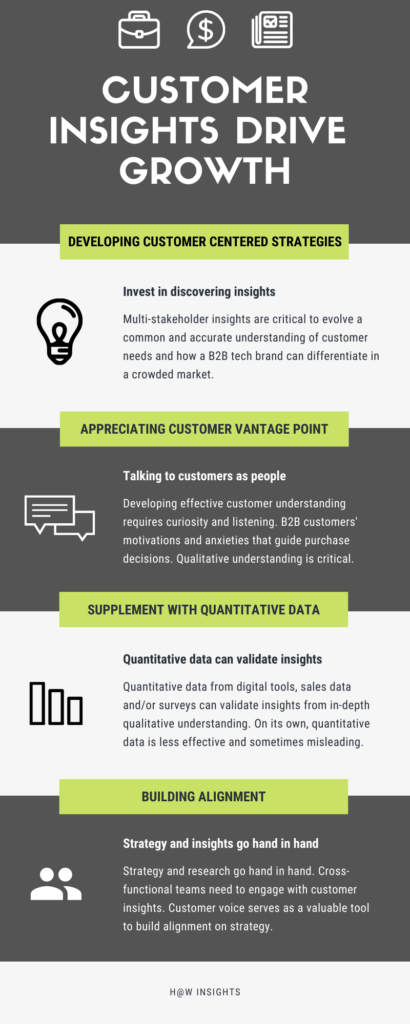Customer insights becoming critical for business success
B2B technology brands operate in a crowded space now. There are numerous technologies, products and companies. Brands need to differentiate to cut through the clutter.
However, it is increasingly difficult to differentiate on products and technology. Operational excellence – ‘Faster, better, cheaper’ claim too doesn’t last very long. Most technology companies are able to replicate and offer an acceptable level of product and service.
The days of customers flocking to a few tech brands are behind us. Large companies have strong procurement teams and sophisticated asks. They need their partners to understand their needs and articulate how they could add value. With easy availability of information online, buyer’s journey has changed. Providing general product collaterals and information does not cut it.
Moreover, B2B technology firms need to cater to clients whose expectations are shaped by their experiences as consumers. The B2B buyer has come to expect differentiated experiences from the brands they consider and buy. This means B2B technology brands need to understand both stated and unstated customer needs, suggest solutions and engage effectively across the buying journey.
Deep and nuanced understanding of customer needs, therefore, is critical to truly deliver a differentiated promise and experience. This requires not only understanding the company requirements but also the personal motivations and barriers in the client team – buyers, influencers, users, champions.

Actionable insights are objective and comprehensive
A good customer insight approach would
- Provide an in-depth understanding of customer segments: It delivers a nuanced understanding of how customer requirements vary by type of business, company size, life stage, sectors, company leadership and culture. There is a need to go beyond merely measurable data and stated needs.
- Deliver actionable insights into buyer journeys among different segments: It provides understanding of buyers, influencers and other gatekeepers, complete with an understanding of motivations, barriers and objectives of each purchase. These insights can influence all aspects of a B2B brand from product design to marketing content and sales conversations.
- Shape content to resonate with customers: As content becomes integral to B2B tech marketing, customer insights enable brands to tell compelling stories with their content. Such content reflects an empathetic understanding of the buyer, his motivations and barriers, the buyer journey and the challenges and need gaps at each point in the journey. This leads to better conversions, engagement and eventually sales.
Insight development process fosters alignment
When tech companies are small, teams work closely together. They have a reasonable and coherent understanding of the customer. There are greater chances of consistency in sales conversations, messaging on websites, blogs and other channels of communication.
As companies grow, sales, marketing, customer success and product teams begin to operate in silos. Distancing of teams leads to the brand distancing from the customer. Each team works with their own understanding of customer needs. Technology companies typically rely on sales teams to provide the necessary customer insights. This creates its own challenges.
- Sales teams are busy and unable to devote time develop a consistent understanding of the customer within the organisation.
- Customer and sales team conversations have specific agendas and does not allow for complete understanding of the customer profiles to develop. Deeper understanding of customers require information beyond the context of direct interaction with the sales or even the product and service team. All interactions need to be buttressed with independent data available digitally and from other conversations. It needs an insights mindset to derive insights.
⇒ We worked with a leading technology brand in Asia. The sales & marketing team believed that the brand’s value proposition lay in its differentiated products while the customers felt that most global brands provided products & par and this Brand’s differentiator lay in the culture of the organisation. The brand had been a product leader and the story made sense then. It was not relevant now with the changed market context. A brand’s story can change to become more relevant when customer voice is brought in.
- Customer insights is effective in bringing alignment around a strategy – positioning & messaging, business challenge, product & service ideas and changes. Without customer insights as an important factor in decision making, we have seen many discussions becoming endless iterations of opinions.
⇒ We were engaged to develop positioning for a global technology company. We decided to develop the positioning strategy based on internal stakeholder insights. With company and market context rapidly changing, every stakeholder had his own interpretation of what the customers needed, thought and felt. Months passed by and there was no consensus and consequently no action on the positioning.
⇒ Recently, we worked on developing a funding and marketing strategy for an ed-tech enterprise. The entire process was driven by customer conversations and insights complemented by internal stakeholder insights. Within 6 months we had aligned on a strategy, briefed agencies and launched a highly successful digital campaign.
B2B technology brands need to make customer insights integral to their sales & marketing as well as product development roadmaps. There must be a structured and ideally an independent effort that brings together analytical, digital data as well as qualitative understanding of their buyers and organisations they work in.
There are a few ways to achieve this:
- With online tools, global market research has become much more affordable.
- There are numerous data feeds (social media, analytic tools) available that a skilled insights professional can synthesize into actionable inputs for a brand to create a differentiated and effective customer buying journey and experience.
- Importantly, insights development is an iterative and ongoing process and needs to be interlinked with business goals and strategies.
An effective insights development process would proceed as follows:
- Clarify the business challenge or opportunity that needs to be solved. Ideally, rope in a cross functional team to brainstorm. Engaging different teams at this stage also helps develop buy-in for the insight process.
- Define research objectives and questions. Assess if it can be carried out by internal team or you need to engage an independent agency.
- Design the research – customer conversations needed, analytics data to be studied, any quantitative survey to be run
- Develop discussion guides, survey forms etc.
- Conduct research. Have an interim checkpoint with the cross functional team (in step 1) to review hypotheses and refine the research.
- Analyse and synthesize findings to answer the research questions as well as define key action items emerging from customer insights
- Present to the cross-functional team as well as key stakeholders to inform customer strategy and tactics. A workshop around the business issue and customer insights is very effective at this stage.
Monika Gera. Marketer with special interest in bringing customer voice to boardrooms.

Monika Gera is Founder of HigherAtWork, a specialist market research and brand strategy consultancy that works with B2B and B2C brands.
www.linkedin.com/in/monikagera
Photo by Franki Chamaki on Unsplash



